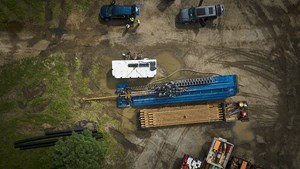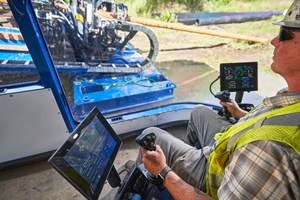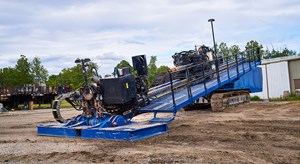March 2024 Vol. 79 No. 3
Features
American Augers’ catch-rig technology speeds up intersect drilling process
by Tom Jackson, Contributing Editor
Today’s maxi-HDD installations often require contractors to operate on both sides of the installation to mitigate risk. Additionally, a two-side operation can help operators intersect pilot bores, manage fluid cleaning or pumping, assist exit side pipe handling and offer power assistance in difficult bore hole conditions.
The practice of employing rigs at both ends of maxi-HDD bores typically begins with lengthier projects requiring intersecting pilot bores. Here, the bore hole is formed when both rigs drill towards a centralized area, then are guided to merge into one continuous bore hole. The predetermined drive rig then follows the exit side drill string back to the surface, allowing the subsequent hole-opening process to take place.
Managing the tail string
One challenge in the process is to ensure a continuous string of drill pipe in the hole at all times. Depending on the project, the exit side of the bore will determine the method of managing the tail string as the bore hole progresses.
Previously, contractors had to get creative when managing the drill pipe and fluid flows on this exit side. Operators often spent significant time devising more-efficient methods for executing procedures, such as manual pipe connections, live rotating tail strings and fluid swivels. Additionally, fluid containment, cleaning and pumping all demand careful attention and effort to ensure the bore progresses effectively.
To streamline the collaboration of two HDD rigs efficiently working together, American Augers developed what it calls “catch-rig” technology. The system is ideally suited for river crossings and long-distance bores that require a lot of time, machines and prep work on the trail pipe at the exit hole.
“A catch rig gets rid of the need to have a swivel on the front of the rotary on the exit side rig,” said Richard Levings, American Augers product manager. “That swivel also has a fluid hose connected to it and operators often pump fluid from the exit side, depending on which side of the bore the fluid is running to, because they have to reclaim on both sides and pump back.”
As a bonus, the rotary fluid swivel used on normal HDD rig operations can be used to pump fluid from the exit side, eliminating the need to insert an external swivel for each and every new joint added or subtracted. This greatly improves the efficiency of pumping fluid from the exit side when fluid is flowing to that side of the bore.
Risk reduction
With efficiency in mind, American Augers focused on using an additional HDD rig on the exit side (already present as an intersect rig) to hydraulically make and break each pipe added or subtracted. In order to do this, the rotary system had to be capable of being put in neutral or enabled by a finger touch on the control screen of the drill.
The catch rig can thread the new pipe on or break the pipe joint, depending on the direction of the drill string movement.
“Using rig wrenches greatly mitigates risks and ensures a time-efficient connection,” said Levings. “Once the connection has been made, the rotary is put in neutral and does not interfere with the rotary power of the drive rig.”
Keeping the pipe moving during the hole-opening and swabbing phase of the boring process is key to reducing risks and costs associated with solids in the bore hole. By using a catch rig with this patented technology, crews experience significantly reduced dwell time in the fluid stream, which keeps the solids in suspension, making them easier to move from the hole to the surface. Another major benefit is the reduced number of days it requires to complete the total project.
“Contractors are always looking for ways to do projects for less money and fewer people,” said Levings, “and labor is the most difficult thing they have to deal with on a day-to-day basis. This catch-rig technology helps contractors be more efficient, reduce the time on projects and save money.”
American Augers has not done time trials or case studies yet, but Levings estimates, conservatively, that contractors could save 15 minutes per pipe connection.
“On a 3,000-foot bore, where there are 100 connections of 30-foot pipe, that’s a lot of time saved, plus you are not dealing with the swivel and multiple people to make the connections,” he said. “All that can be done with the catch rig in less than two minutes with two people.”
And because two rigs are needed for an intersect bore, it only makes sense for the crews to finish the backreaming and swab passes using catch-rig technology since in any intersect HDD job, they will already have the second machine on site.
FOR MORE INFORMATION:
American Augers, (419) 869-7107 or (800) 324-4930, americanaugers.com







Comments